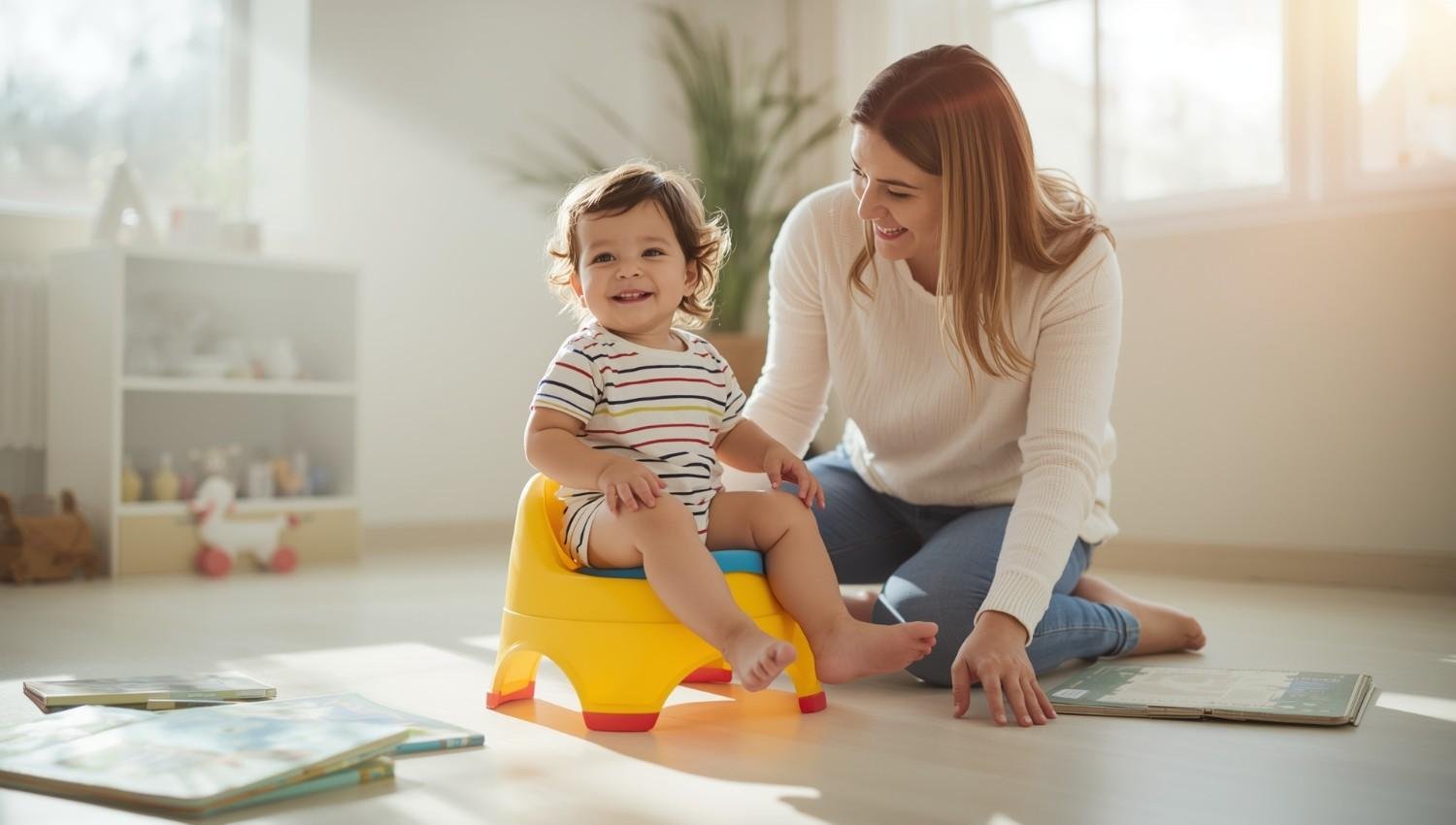If you’ve landed here, chances are you’ve been tiptoeing around the idea of potty training, wondering when and how to start — or perhaps you’ve already tried and given up after a few tears (from both you and your toddler). You’re not alone.
When I started potty training my first child, I was terrified I’d do it “wrong.” I read endless parenting forums, bought all the recommended potty gadgets, and spent way too long waiting for the perfect moment. Spoiler alert: it never came.
What I eventually learned — through a lot of trial, error, and accidents — is that potty training doesn’t need to be complicated. The key is consistency, confidence, and a little bit of humor. This is the guide I wish I had before I started: real, practical advice that works in the real world, with real toddlers.
When Should You Start Potty Training?
There’s no universal magic age, but I’ll tell you this — starting earlier (around 22–26 months) made all the difference for us. Toddlers at this stage still want to please you. They love being praised, they mimic easily, and they haven’t quite reached the full “my way or the highway” independence of a threenager.
By three, most kids have stronger opinions, more resistance, and sharper negotiation skills (“No potty, Mommy, maybe later!”). So, if your child is showing even mild signs of readiness — like staying dry for longer stretches, showing interest in your bathroom habits, or trying to pull off a wet diaper — that’s your green light.
Remember: readiness isn’t perfection. It’s just the beginning of willingness.
Step 1: Prepare Yourself (and Your House)
Potty training success starts before you even say goodbye to diapers. You need a plan, the right mindset, and the right supplies.
A. Get your child on board
Start by casually talking about how exciting it is to be a “big kid.” Read potty-themed books together, watch shows like Daniel Tiger’s Potty Time, and point out how grown-ups or older siblings use the toilet. The goal is to plant the seed — not pressure them.
B. Pick the right weekend
If you work full-time, start on a Friday night or Saturday morning so you have at least three uninterrupted days at home. Consistency is key, and the first 72 hours are the foundation for everything.
C. Prepare your environment
You’ll need:
- A child potty or seat insert (one for home and one for the car if possible)
- Lots of paper towels and disinfecting wipes
- Easy-off clothing (loose shorts or dresses, no tricky buttons)
- A reward chart or small motivators (optional)
- A calm, patient attitude (mandatory!)
D. Loop in your daycare provider
If your child attends daycare, send them a quick note or printout explaining your potty routine, what words your child uses (“pee-pee,” “potty,” “poo-poo”), and what helps most. Teamwork between home and daycare makes a huge difference in consistency.
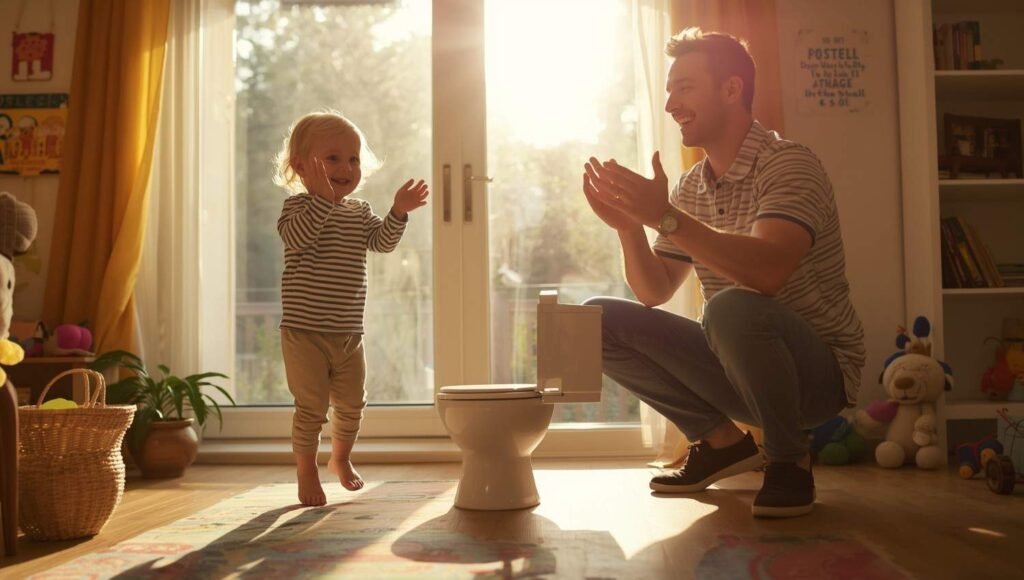
Step 2: The Naked Phase — Day 1
This is where the magic (and mess) happens. Day 1 is about awareness — helping your child connect the feeling of needing to go with the act of going on the potty.
Here’s how our first day looked:
1. Ditch the diapers completely
The moment your child wakes up, explain simply:
“Today we’re not wearing diapers anymore. We’re going to use the potty like big kids!”
Then keep them bottomless. No underwear, no pants. Underwear at this stage feels too similar to a diaper, and it confuses the brain’s muscle memory. Naked is best — even if your floors disagree.
2. Watch like a hawk
Your job is part detective, part cheerleader. Follow them closely all day. Look for the telltale cues — wiggling, pausing mid-play, hiding behind furniture — and swoop in fast. Gently guide them to the potty every hour, even if they insist they don’t have to go.
Avoid asking “Do you need to go?” because the answer will almost always be no. Instead, tell them, “Let’s go pee now!” and make it fun or routine.
3. Celebrate every success
When they go in the potty — even a tiny bit — throw a mini party. Clap, cheer, make their favorite stuffed animal “talk” or sing a song. You don’t need candy or stickers (though you can use them sparingly). The joy of making you proud is often motivation enough.
4. Handle accidents with calm firmness
Accidents are not failures. They’re feedback. Keep your tone neutral and confident:
“Pee goes in the potty, not on the floor. Let’s clean it up together.”
This language reinforces the goal without shame or confusion.
By the end of Day 1, expect multiple accidents — that’s normal. But also expect the first lightbulb moment where your child suddenly “gets it.”
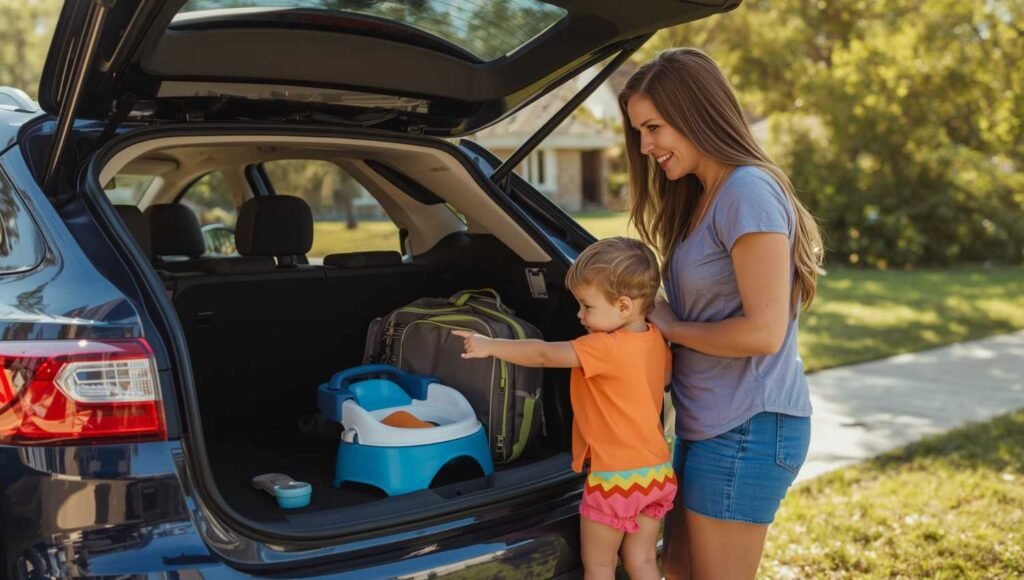
Step 3: Day 2 and 3 — Repetition and Routine
If Day 1 was about awareness, Days 2 and 3 are about repetition.
Keep your child mostly naked at home, but introduce short trips to the potty every hour. You’ll start to see patterns — like when they usually poop, or which cues mean “urgent.”
Step-by-Step Schedule
- Morning potty right after waking up
- Potty before meals
- Potty before and after naps
- Potty before bedtime
- Hourly check-ins in between
If your child starts staying dry between potty trips, that’s huge progress.
Add loose clothing
Once you’ve had a full day or two of mostly dry results, add pants (still no underwear). This gives them a chance to practice pulling pants up and down without the false security of underwear.
If things regress, go back a step — naked again for a day or two — until the pattern resets.
Step 4: Life Beyond the Living Room — Leaving the House
Venturing out after the first few days can feel nerve-wracking, but it’s an essential step. Here’s how to make it easier:
1. Keep outings short
Limit trips to 30–60 minutes at first. Always potty before leaving and immediately after arriving.
2. Identify bathrooms early
Show your child the restroom as soon as you enter a new place. This normalizes the process and reduces panic later.
3. Expect the unexpected
Carry:
- 2–3 pairs of pants and underwear
- Wipes and paper towels
- A small plastic bag for soiled clothes
- A portable potty seat (life saver for road trips)
4. Public restroom tips
Cover automatic toilet sensors to prevent scary surprise flushes. Some kids freeze up at the sound — especially during early confidence building.
5. Stay calm during setbacks
Accidents in public are not embarrassing — they’re opportunities to teach resilience. The calmer you stay, the quicker your child will recover emotionally.
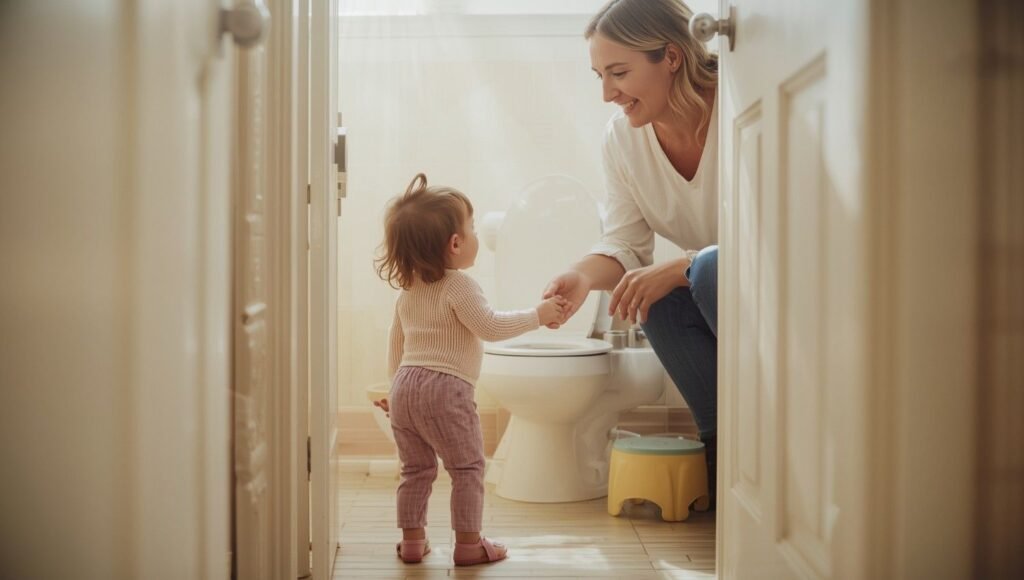
Step 5: Nap and Night Training
Daytime potty success doesn’t automatically mean nighttime dryness. In fact, nap and night training are more about biology than behavior. But here’s how to gently transition:
1. Start with naps
Once your child consistently wakes up dry after naps for about a week, it’s time to remove the nap diaper. Make sure they potty right before sleep and limit fluids 30 minutes beforehand.
2. Nighttime training
Nighttime dryness often lags behind daytime by months — and that’s okay. Start when your child wakes up dry most mornings or expresses interest in ditching pull-ups.
Practical steps:
- Layer waterproof mattress protectors (sheet + protector + sheet)
- Stop liquids after 6:30 PM
- Potty before bed (and again if they wake during the night)
- Praise every dry morning
For some parents, a gentle “dream pee” — waking your child for a sleepy bathroom trip around 10 PM — helps during the first few weeks.
3. When accidents happen
Respond calmly:
“That’s okay, your body is still learning when it’s time to go. Let’s change and try again tomorrow.”
The key is patience. Over time, their bladder will mature, and they’ll naturally stay dry through the night.
Step 6: Reinforcement and Confidence Building
Potty training doesn’t end once they’re officially diaper-free. There’s an adjustment period — sometimes months — where consistency and confidence need to be reinforced.
Here’s how to keep progress going strong:
1. Use praise wisely
Overpraising can create pressure; underpraising can lead to apathy. Aim for calm, confident affirmation:
“You listened to your body — great job!”
2. Maintain routine
Even after success, stick with regular potty breaks throughout the day. Predictability helps prevent regression during travel, illness, or big life changes.
3. Model normal bathroom habits
Let your child see you use the toilet. Toddlers learn best through imitation — and bathroom privacy can wait a few years.
4. Handle regressions gently
Regression happens — during a move, a new sibling, or a change in routine. Avoid frustration; simply go back to basics for a few days.
5. Keep communication open
If your child resists or feels embarrassed, remind them that everyone learns at their own pace. Keep humor and empathy in the mix — it’s your greatest tool.
Step 7: Common Mistakes to Avoid
Even with the best intentions, certain missteps can derail progress. Learn from my experience so you don’t have to repeat it.
- Starting too late – Waiting for “perfect readiness” often leads to power struggles.
- Asking too many questions – Toddlers almost always say no. Be direct and calm instead.
- Using pull-ups during the day – They feel too much like diapers and confuse the process.
- Punishing accidents – This creates shame and anxiety.
- Pushing when your child resists – Take a short break and try again in a week.
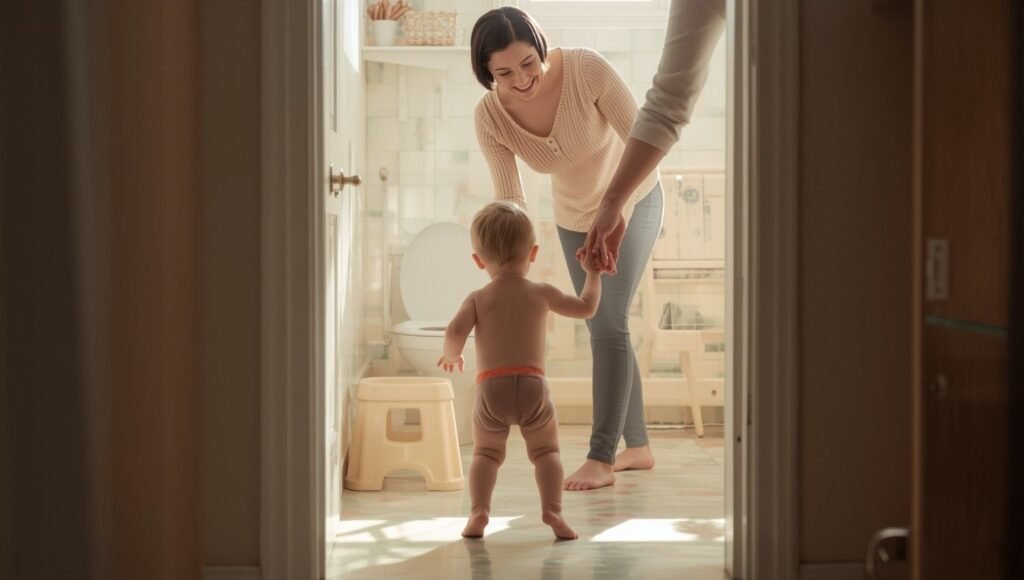
Final Thoughts: Believe in Your Child (and Yourself)
The most powerful lesson I learned through potty training is that your confidence becomes their confidence. When you approach the process with trust and optimism, your child feels safe to try, fail, and succeed.
There’s no need to compare your timeline to others’. Whether it takes three days or three months, every small step counts. What matters most is the pride your child feels when they realize they did something “big kid” all on their own.
Potty training isn’t just about teaching a skill — it’s about building independence, trust, and connection.
And when you finally put away that last box of diapers, you’ll realize something: it wasn’t just your toddler growing up — it was you, too.
Frequently Asked Questions About Potty Training
1. What are the signs that my child is ready to start potty training?
Every child is different, but most toddlers start showing signs of readiness between 18 and 30 months. Some clear indicators include:
- Staying dry for longer than 2 hours at a time
- Showing interest in your bathroom habits or asking about the toilet
- Disliking dirty diapers or asking to be changed
- Being able to pull pants up and down independently
- Using simple words to tell you when they’ve gone or need to go
If your child is showing even a few of these signs, it’s a great time to begin gently introducing the potty concept.
2. Is there a “perfect age” to potty train?
There’s no universal perfect age, but starting before three years old tends to be easier. Children closer to two are generally more eager to please, less opinionated, and more open to guidance. By three, they often crave control and independence, which can turn potty training into a battle of wills.
That said, the right time is when you and your child both feel ready to be consistent. Readiness trumps age every time.
3. Should I use rewards like candy or stickers?
Rewards can work for some families but may backfire for others. A small, short-term incentive (like a sticker for each potty success) can be motivating, but avoid long-term dependence on bribes like candy or toys.
Praise, encouragement, and excitement tend to be more sustainable. When a child sees your genuine pride in their accomplishment, it builds intrinsic motivation — they’ll do it because they’re proud of themselves, not just for a treat.
4. What if my child refuses to sit on the potty?
This is very common — and it’s not defiance so much as discomfort with something new. Here’s what helps:
- Make the potty fun: Let them decorate it with stickers or “introduce” it to their favorite stuffed animal.
- Let them observe you or an older sibling. Kids learn best by imitation.
- Never force them to sit. Instead, make it part of a predictable routine — “We sit on the potty before we go outside,” for example.
- Use humor and pretend play. Have a toy “use” the potty first!
If resistance continues for more than a few days, pause and try again in a week or two. Forcing the issue can create negative associations.
5. How do I handle accidents without discouraging my child?
Accidents are part of the process — think of them as information, not failures.
Stay calm and use clear, factual language like:
“Pee goes in the potty. Let’s clean up and try again next time.”
Avoid saying “It’s okay” (which can sound like permission) or showing frustration (which creates shame). Your calm response teaches your child that mistakes are safe and fixable, which builds confidence.
6. What if my child is scared to poop on the potty?
This is one of the most common potty training challenges. Many toddlers fear the sensation of letting go — especially if they’ve ever been constipated.
Try these tips:
- Read books about pooping (yes, really — kids’ humor helps normalize it!)
- Have your child sit on the potty right after meals, when digestion naturally triggers the urge.
- Keep their feet supported with a stool — dangling legs make it harder to relax.
- Praise even sitting on the potty, not just success.
If constipation is an issue, talk to your pediatrician. Once the fear passes, progress happens quickly.
7. Should I use pull-ups?
Pull-ups can be useful during naps, nighttime, or long outings, but they slow daytime progress if used regularly. Because they feel like diapers, many toddlers treat them the same way.
If you must use pull-ups temporarily, call them “special underwear” and keep the same potty expectations — don’t revert to diaper habits.
8. How do I coordinate potty training with daycare or babysitters?
Consistency is everything. Talk to caregivers in advance and share:
- Your potty schedule and cues
- What words your child uses for potty and poop
- Whether you’re using rewards or not
- How to respond to accidents
Most daycare providers are experienced with potty training, but communication ensures your child gets consistent messaging everywhere.
9. What about potty training boys versus girls?
The process is nearly identical, though some boys may take a bit longer to fully master bladder control.
For boys:
- Start with sitting down to pee until they’re comfortable.
- Once they’re confident, you can introduce standing (often with dad or brother modeling).
- Cheerios or small targets in the toilet can make it fun to aim.
For girls:
- Teach them to wipe front to back to prevent infections.
- Dresses and skirts make potty trips easier in the early days.
The most important rule? Don’t compare. Every child — boy or girl — learns at their own pace.
10. How long does potty training take?
Many “three-day” potty training methods exist, but complete mastery (including poop, naps, nights, and outings) can take weeks or even months.
Here’s a realistic breakdown:
- Initial learning: 3–7 days
- Consistent daytime success: 2–4 weeks
- Nap and nighttime dryness: 2–6 months (sometimes longer)
Progress often happens in bursts — a few days of breakthroughs followed by plateaus. Patience and consistency will win in the long run.
11. How can I handle regression after success?
Regression happens to nearly every child. Common triggers include:
- New baby in the family
- Starting school or daycare
- Moving to a new home
- Illness or travel disruptions
When it happens, don’t panic. Go back to basics for a few days — more reminders, positive reinforcement, and shorter intervals between potty breaks. Reassure your child that they’re not in trouble and that their body just needs a little reminder.
12. How do I transition from potty to toilet?
Once your child is confidently using the potty chair, start introducing the big toilet.
Tips:
- Use a step stool and a child seat insert for stability.
- Let them flush and wash hands as part of the “big kid” routine.
- Alternate between the potty and the toilet for a few weeks until they prefer the latter.
Make it gradual — the goal is confidence, not fearlessness overnight.
13. What should I do if potty training feels like a power struggle?
If every trip to the potty turns into a battle, it’s a sign your child needs more control — not more pressure.
Try offering choices:
- “Do you want to use the red potty or the blue one?”
- “Do you want to go before or after brushing your teeth?”
Framing it as empowerment rather than enforcement changes the energy completely. If tension persists, take a short break (3–7 days) and try again with a clean slate.
14. My child still wakes up wet at night. Should I be worried?
Not at all. Nighttime dryness is linked to bladder maturity and deep sleep cycles, both of which develop at their own pace. Many kids don’t stay dry through the night until age 4 or 5.
Continue:
- Potty before bed
- Limit fluids after dinner
- Encourage morning potty first thing after waking
If nighttime accidents continue past age 6 or cause stress, consult your pediatrician — but for most kids, it’s simply a matter of time.
15. What if I’ve tried everything and it’s just not working?
Take a deep breath — potty training is a marathon, not a sprint. If it feels like you’re stuck:
- Pause for 1–2 weeks and reset.
- Evaluate whether your child is truly ready (emotionally and physically).
- Revisit positive language and routines.
- Reach out to your pediatrician for reassurance or rule out medical causes like constipation or urinary tract issues.
You’re not failing — you’re learning together. And every attempt gets you one step closer.
Final Reassurance
Remember, there’s no prize for “fastest trained toddler.” What matters is that your child feels safe, confident, and supported through the process.
Potty training is a huge milestone — not just for your little one, but for you too. The patience, consistency, and belief you invest now will pay off in independence, trust, and pride for years to come.

